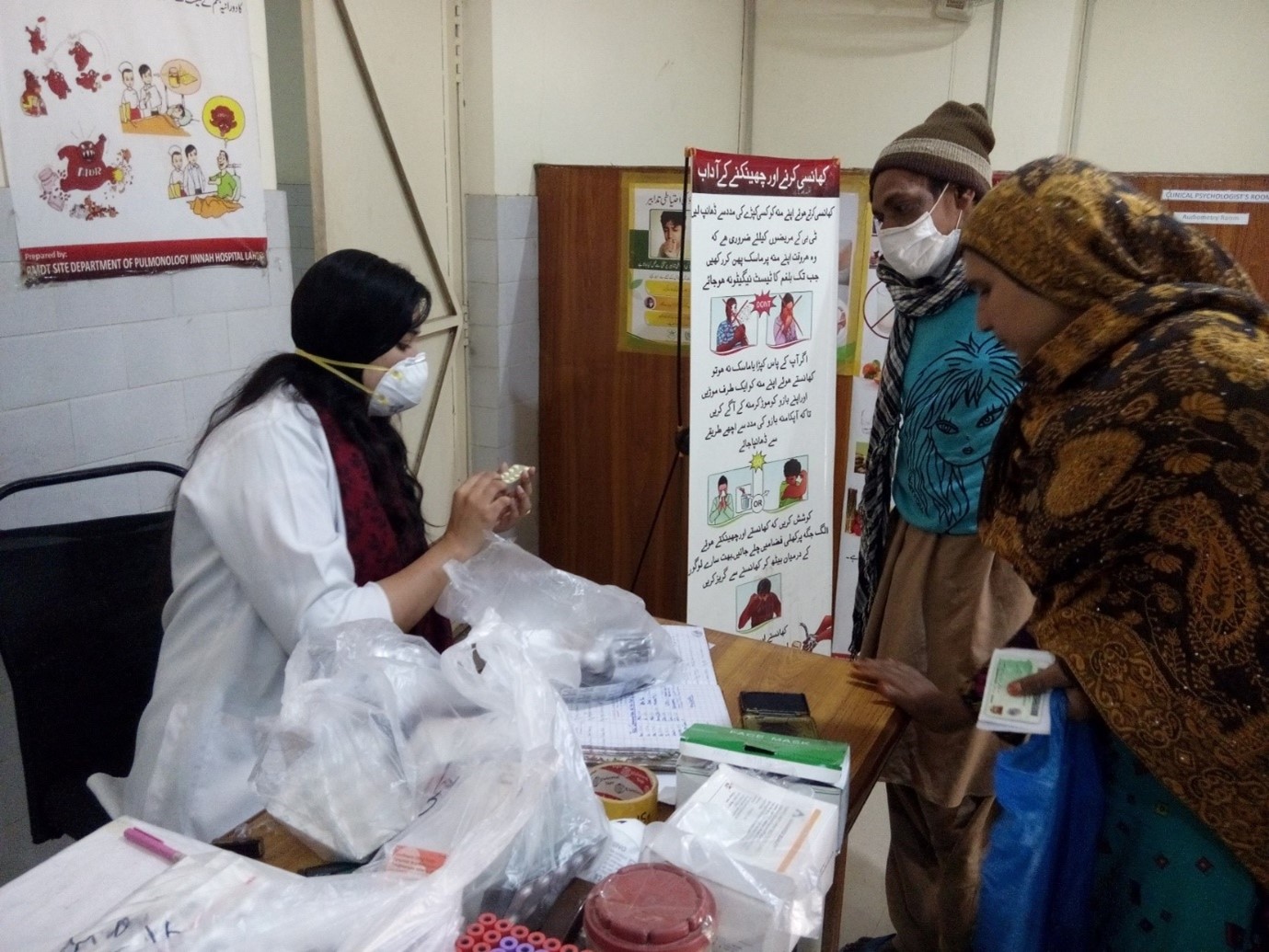An implementation research study supported by TDR’s Impact Grants for Regional Priorities and carried out by the Environmental Health team at Pakistan’s National Institutes of Health has assessed the full cost of tuberculosis (TB) care that patients and families face. Through the study the team have identified key factors contributing to the catastrophic cost of TB care and have developed policy recommendations that will help public health services control the disease more effectively.

Tuberculosis patients at Jinnah Hospital Lahore collecting their medications.
Pakistan has the fifth-highest prevalence of TB globally. The research team believe their findings will help other countries with high TB prevalence to better understand the full costs of TB for patients and help these countries develop policies to improve treatment adherence and reduce mortality and morbidity associated with the disease.
Here we interview Dr Amna Ali, research coordinator for the Pakistan National Institutes of Health and a member of the research team.
National TB programmes fund the full cost of medicines for TB patients in most countries. Why is more implementation research needed on this topic in Pakistan?
Paying for medicines does not cover the total cost of the TB condition for patients and their families. The full cost results from a combination of practical and societal factors. For many families these cause catastrophic household costs. Such prohibitive costs affect people’s adherence to TB treatment regimens and contribute to the emergence of drug-resistant TB types.
Logistical reasons and other societal factors, such as the stigma of having the illness or fear of losing employment, can also cause people to stop their treatment. Some people stop treatment as soon as they feel better and therefore do not complete the course, causing TB symptoms to return.
What effect does stopping treatment have on public health services?
Stopping treatment, for whatever reason, brings a real risk of patients developing drug-resistant TB types. These types are more difficult to treat, and the medications are also more expensive and are not reimbursed by the national programme.
What specific implementation research question did you address in your project?
We asked: what are the key factors associated with the catastrophic costs of TB care in Pakistan?
What factors contribute to catastrophic household TB costs?
People living in rural areas and slums are the typical government targets for free TB medication. But treatment coverage does not cover other substantial recurring costs that TB patients face. These include travel to a treatment centre, hospitalization, and the need for improved nutrition (which calls for more expensive foods) and multivitamins.
For many households faced with catastrophic TB costs the solution is to borrow money – which starts a debt spiral.
What new learning did you generate in this research?
Our study emphasizes the fact that despite the provision of free treatment in Pakistan, the economic burden faced by patients continues to rise due to total catastrophic costs. It is over-optimistic to assume that covering the cost of medicines alone will play a significant role in minimizing total TB costs to patients and their families. Our results indicate that patients who did not receive paid sick leave were approximately three times more likely to face catastrophic costs in comparison to patients who did. Single-income households were more likely to be affected. Overall, the most important contribution to catastrophic costs was job loss after diagnosis. This shows the complex dynamics of the lack of paid sick leave and a high number of follow-up visits. This adversely affects the employment status of the patient or their guardian – with job loss an ultimate consequence.
Based on your findings, what needs to be done differently?
Policy-makers need to know that catastrophic household costs of TB and related non-adherence to medicines are influenced by three factors: households with a single breadwinner; a lack of follow-up visits and approaches to encourage people to continue the treatment; and the stigma of TB, which can lead to loss of work and income if a person is identified as TB-positive. These issues are also not well understood and addressed by health services.
Policy-makers need to know that poor treatment adherence is a pathway to drug-resistant conditions that are no longer covered by the national system.
Therefore, the primary recommendation to government heads and policy-makers is to put in place healthcare interventions that provide social protection to patients and their guardians. These go beyond providing free TB drugs, diagnostic tests, and nutritional supplements. Interventions must also address the stigma associated with the disease as this plays an important role in income loss and is also the driving force behind social exclusion.
Can your findings benefit healthcare policy-makers and professionals in other countries?
This was the first study of its kind done in Pakistan to assess factors linked to catastrophic costs of TB care. Our research is relevant to other low- and middle-income countries with a high TB prevalence and similar socioeconomic conditions for patients.
This study was compared with similar research conducted in Indonesia; this shows similar factors contributing to catastrophic costs of TB treatment despite the presence of universal health coverage. Our findings can inform the improvement of TB programmes in India, whose health systems and TB programmes have similar economic classes, and Bangladesh.
The Impact Grants for Regional Priorities support researchers and public health practitioners as part of TDR’s collaboration with WHO regional offices. The objective is to produce implementation research findings that can help build national strategies and action plans for better control and treatment of infectious diseases of poverty.
For more information on the Impact Grants programme, please contact Dr Garry Aslanyan.

